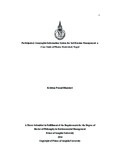Please use this identifier to cite or link to this item:
http://archive.nnl.gov.np:8080/handle/123456789/241| Title: | Participatory geographic information system for soil erosion management: a case study of Phewa watershed, Nepal |
| Authors: | Bhandari, Krishna Prasad |
| Keywords: | Soil erosion management - Phewa watershed -- Nepal Participatory Geographic Information System (PGIS) Revised Universal Soil Loss Equation (RUSLE) Erosion Damage Assessment (EDA) |
| Issue Date: | 11-Dec-2017 |
| Abstract: | This research integrates stakeholder perceptions of socio-economic determinants of soil erosion with the Revised Universal Soil Loss Equation (RUSLE) to identify and assess the major causes of soil erosion. By application of remote sensing using the Landsat ETM 1995 and 2010 imagery , RUSLE, and Participatory Geographic Information Systems (PGIS) based on Erosion Damage Assessment (EDA), major Land Use Land Cover (LULC) changes over the past 15 years in the Phewa watershed could be identified and quantified, and this information used to assist in soil erosion reduction. The methodologies employed include structured questionnaires, focus groups, stakeholders’ sketches, and application of remote sensing and GIS on the RUSLE model. The RUSLE model was applied to find the soil erosion status of the watershed. Soil erosion risk analysis was employed to generate a soil erosion risk map of the study area. The results indicated that the current rate of annual soil erosion in the Phewa Watershed varied from 0 to 206.78 t/ha/yr and the mean annual rate of soil loss was 14.71 t/ha/yr and total average soil loss 181,889 ton/year. Bivariate correlation analysis and stepwise multiple regression analysis revealed that ten socio-economic variables were predictors of soil erosion. The analysis generated five predictive models. The model significantly (p<0.01) explained 89% of the variability in soil erosion rate (R2 = 0.89). The study identified that a number of socio-economic variables, viz. household size, farm labour, education, conservation cost, training, membership of organization committees, distance, farm land size, migration, and farm income, were all predictors of soil erosion. Major decreases in dense forest, increases in open forest, and increases in human settlement in the watershed contributed to increases in soil erosion. The PGIS based EDA resulted in different classes of severity (stable, slight, moderate, severe, and very severe) which were consistent with the quantified result of RUSLE, except for the dense forest class in LULC. Erosion hazard maps were developed using 2 different methods: PGIS based on EDA by stakeholders, and the RUSLE model. The maps showed that the soil erosion risk areas were similar in both methods. The use of participatory geographic information system (PGIS) based EDA knowledge, remote sensing (RS) and geographic information system (GIS) technology for conservation practices could help to reduce soil erosion. Stakeholders’ perceptions, the RS and GIS technique, and PGIS based on the EDA approach all led to better measures for soil erosion management. Thus, the cause and effects of soil erosion were identified by integrating the stakeholder perceptions of socio-economic determinants of soil erosion, RUSLE and LULC changes. Soil erosion risk assessment represented the foundation of sustainable soil erosion management, and contributed appropriate soil conservation measures taken by experts and stakeholders leading to soil erosion reduction in the Phewa watershed. |
| Description: | A Thesis submitted in Fulfillment of the Requirements for the Degree of Doctor of Philosophy in Environmental Management, Prince of Songkla University, 2014. |
| URI: | http://103.69.125.248:8080/xmlui/handle/123456789/241 |
| Appears in Collections: | 500 Natural sciences and mathematics |
Files in This Item:
| File | Description | Size | Format | |
|---|---|---|---|---|
| Final Thesis.pdf | 17.99 MB | Adobe PDF |  View/Open |
Items in DSpace are protected by copyright, with all rights reserved, unless otherwise indicated.